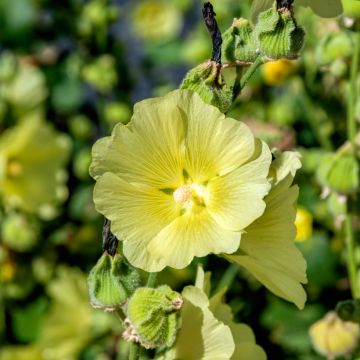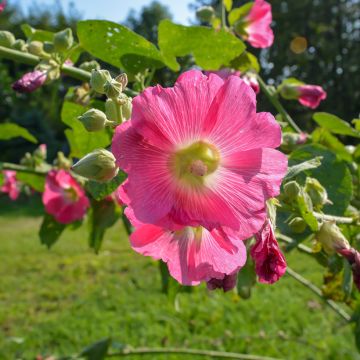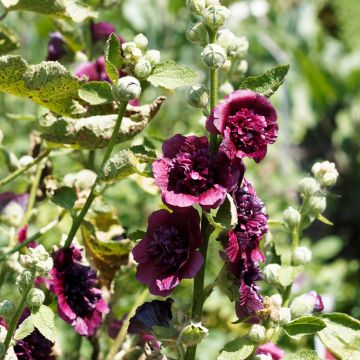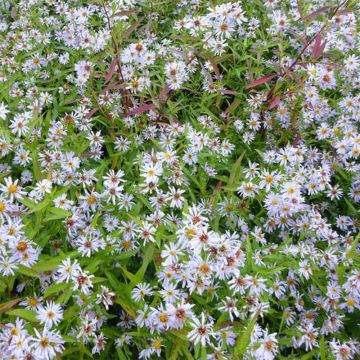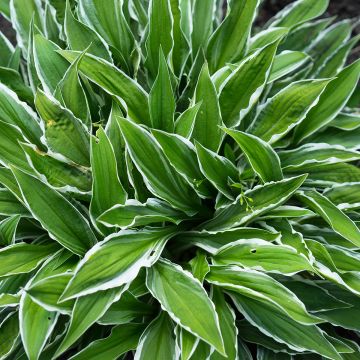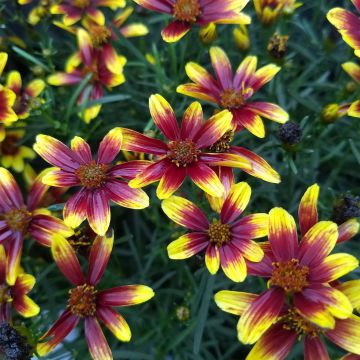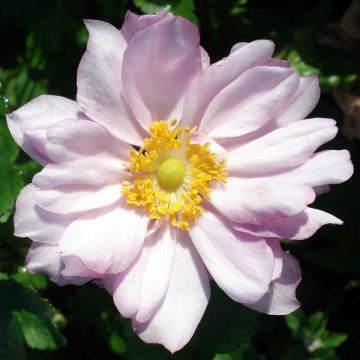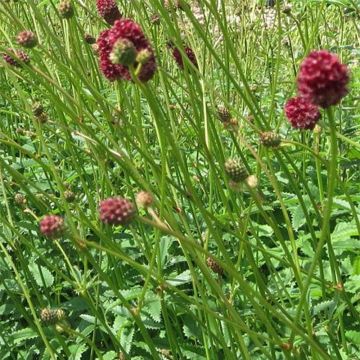

Alcea rosea 'Simplex'


Alcea rosea 'Simplex'


Alcea rosea 'Simplex'
Alcea rosea 'Simplex'
Alcea rosea Simplex
Rose-trémière, Passe-rose, Passerose, Rose trémière, Rose papale
This item cannot be shipped to the selected country
Delivery charge from €5.90
More information
Schedule delivery date,
and select date in basket
This plant carries a 12 months recovery warranty
More information
We guarantee the quality of our plants for a full growing cycle, and will replace at our expense any plant that fails to recover under normal climatic and planting conditions.
From €5.90 for pickup delivery and €6.90 for home delivery
Express home delivery from €8.90.
Does this plant fit my garden?
Set up your Plantfit profile →
Description
The Alcea rosea 'Simplex' is a simple version of the hollyhock, the quintessence of this authentic perennial that wanders so naturally in abandoned gardens. It reaches towards the sky, offering large spikes adorned with single flowers, graceful like those of hibiscus, in a varied palette of shades. This classic variety is timeless, and truly perfect in the background of a border. It thrives in poor, rocky soils, shows tolerance to drought, and prefers warm locations.
The hollyhock 'Simplex' is also known by its Latin name Althaea rosea 'Simplex', and its vernacular names adopt all the accents of our regions: it is called Passe-rose, Rose à bâton, Rose papale or primerose. From the mallow family, it is native to Asia Minor and often naturalised in neglected gardens, fallow fields, and mounds of soil. This 'Simplex' variety is part of an old series, with plants showing various colours and proving to be truly perennial and not biennial. It is an upright, usually unbranched plant that can reach a height of 1.20 to 1.80m (4 to 6ft). It forms a rosette of rounded leaves from which a robust floral spike emerges, with very rapid growth. These spike-like inflorescences are covered with large buds that bloom, staggered from June to August, sometimes even until October, and from bottom to top, into large single flowers (5 to 10 cm (2 to 4in) in diameter) that only last for a day. They display soft or vibrant hues, white, different shades of pink, or light red to dark red, solid or almost bicoloured, and a texture that allows the green reflections of the surrounding vegetation to shine through. Throughout this period, they will attract bees and butterflies to your garden. The flowering gives way to numerous fruits filled with seeds that self-sow in the most unexpected areas, chosen by the plant itself: at the base of walls, in poor, rocky soils, crevices in walls, etc.
The foliage of Alcaea rosea is deciduous. The alternate leaves, 15 cm (6in) long, are pale green. These large leaves are rounded and rough. They are divided into 3 to 7 shallow lobes.
Very common in abandoned gardens or fallow fields in our countryside, the hollyhock is often grown in the background of a border or leaning against a wall that protects it from strong winds. The simple and very bright colours of this variety will allow you to create superb combinations with dwarf buddleias, tall perennials with light foliage (fennel, linaria, Ferula communis, Datisca cannabina, Melianthus major), or with voluptuous grasses like Miscanthus, Panicum, etc. The hollyhock is an edible plant, the flower buds can be consumed raw in salads and the young leaves raw or cooked.
The hollyhock is both ornamental and medicinal. Its seeds yield an oil with drying properties. Rich in mucilage, it has soothing, emollient, expectorant, laxative, and appetising properties.
Report an error about the product description
Alcea rosea 'Simplex' in pictures
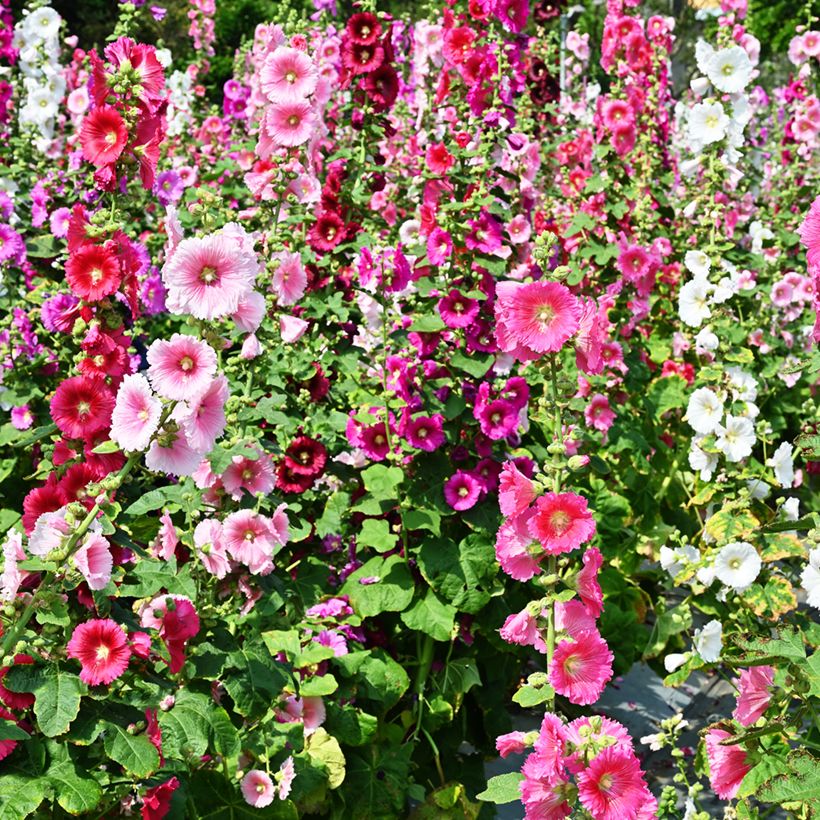





Flowering
Foliage
Plant habit
Botanical data
Alcea
rosea
Simplex
Malvaceae
Rose-trémière, Passe-rose, Passerose, Rose trémière, Rose papale
Cultivar or hybrid
Other Alcea rosea - Hollyhocks
Planting and care
Planting period
Intended location
Care
-
, onOrder confirmed
Reply from on Promesse de fleurs
Summer flowering perennials
Haven't found what you were looking for?
Hardiness is the lowest winter temperature a plant can endure without suffering serious damage or even dying. However, hardiness is affected by location (a sheltered area, such as a patio), protection (winter cover) and soil type (hardiness is improved by well-drained soil).

Photo Sharing Terms & Conditions
In order to encourage gardeners to interact and share their experiences, Promesse de fleurs offers various media enabling content to be uploaded onto its Site - in particular via the ‘Photo sharing’ module.
The User agrees to refrain from:
- Posting any content that is illegal, prejudicial, insulting, racist, inciteful to hatred, revisionist, contrary to public decency, that infringes on privacy or on the privacy rights of third parties, in particular the publicity rights of persons and goods, intellectual property rights, or the right to privacy.
- Submitting content on behalf of a third party;
- Impersonate the identity of a third party and/or publish any personal information about a third party;
In general, the User undertakes to refrain from any unethical behaviour.
All Content (in particular text, comments, files, images, photos, videos, creative works, etc.), which may be subject to property or intellectual property rights, image or other private rights, shall remain the property of the User, subject to the limited rights granted by the terms of the licence granted by Promesse de fleurs as stated below. Users are at liberty to publish or not to publish such Content on the Site, notably via the ‘Photo Sharing’ facility, and accept that this Content shall be made public and freely accessible, notably on the Internet.
Users further acknowledge, undertake to have ,and guarantee that they hold all necessary rights and permissions to publish such material on the Site, in particular with regard to the legislation in force pertaining to any privacy, property, intellectual property, image, or contractual rights, or rights of any other nature. By publishing such Content on the Site, Users acknowledge accepting full liability as publishers of the Content within the meaning of the law, and grant Promesse de fleurs, free of charge, an inclusive, worldwide licence for the said Content for the entire duration of its publication, including all reproduction, representation, up/downloading, displaying, performing, transmission, and storage rights.
Users also grant permission for their name to be linked to the Content and accept that this link may not always be made available.
By engaging in posting material, Users consent to their Content becoming automatically accessible on the Internet, in particular on other sites and/or blogs and/or web pages of the Promesse de fleurs site, including in particular social pages and the Promesse de fleurs catalogue.
Users may secure the removal of entrusted content free of charge by issuing a simple request via our contact form.
The flowering period indicated on our website applies to countries and regions located in USDA zone 8 (France, the United Kingdom, Ireland, the Netherlands, etc.)
It will vary according to where you live:
- In zones 9 to 10 (Italy, Spain, Greece, etc.), flowering will occur about 2 to 4 weeks earlier.
- In zones 6 to 7 (Germany, Poland, Slovenia, and lower mountainous regions), flowering will be delayed by 2 to 3 weeks.
- In zone 5 (Central Europe, Scandinavia), blooming will be delayed by 3 to 5 weeks.
In temperate climates, pruning of spring-flowering shrubs (forsythia, spireas, etc.) should be done just after flowering.
Pruning of summer-flowering shrubs (Indian Lilac, Perovskia, etc.) can be done in winter or spring.
In cold regions as well as with frost-sensitive plants, avoid pruning too early when severe frosts may still occur.
The planting period indicated on our website applies to countries and regions located in USDA zone 8 (France, United Kingdom, Ireland, Netherlands).
It will vary according to where you live:
- In Mediterranean zones (Marseille, Madrid, Milan, etc.), autumn and winter are the best planting periods.
- In continental zones (Strasbourg, Munich, Vienna, etc.), delay planting by 2 to 3 weeks in spring and bring it forward by 2 to 4 weeks in autumn.
- In mountainous regions (the Alps, Pyrenees, Carpathians, etc.), it is best to plant in late spring (May-June) or late summer (August-September).
The harvesting period indicated on our website applies to countries and regions in USDA zone 8 (France, England, Ireland, the Netherlands).
In colder areas (Scandinavia, Poland, Austria...) fruit and vegetable harvests are likely to be delayed by 3-4 weeks.
In warmer areas (Italy, Spain, Greece, etc.), harvesting will probably take place earlier, depending on weather conditions.
The sowing periods indicated on our website apply to countries and regions within USDA Zone 8 (France, UK, Ireland, Netherlands).
In colder areas (Scandinavia, Poland, Austria...), delay any outdoor sowing by 3-4 weeks, or sow under glass.
In warmer climes (Italy, Spain, Greece, etc.), bring outdoor sowing forward by a few weeks.





































